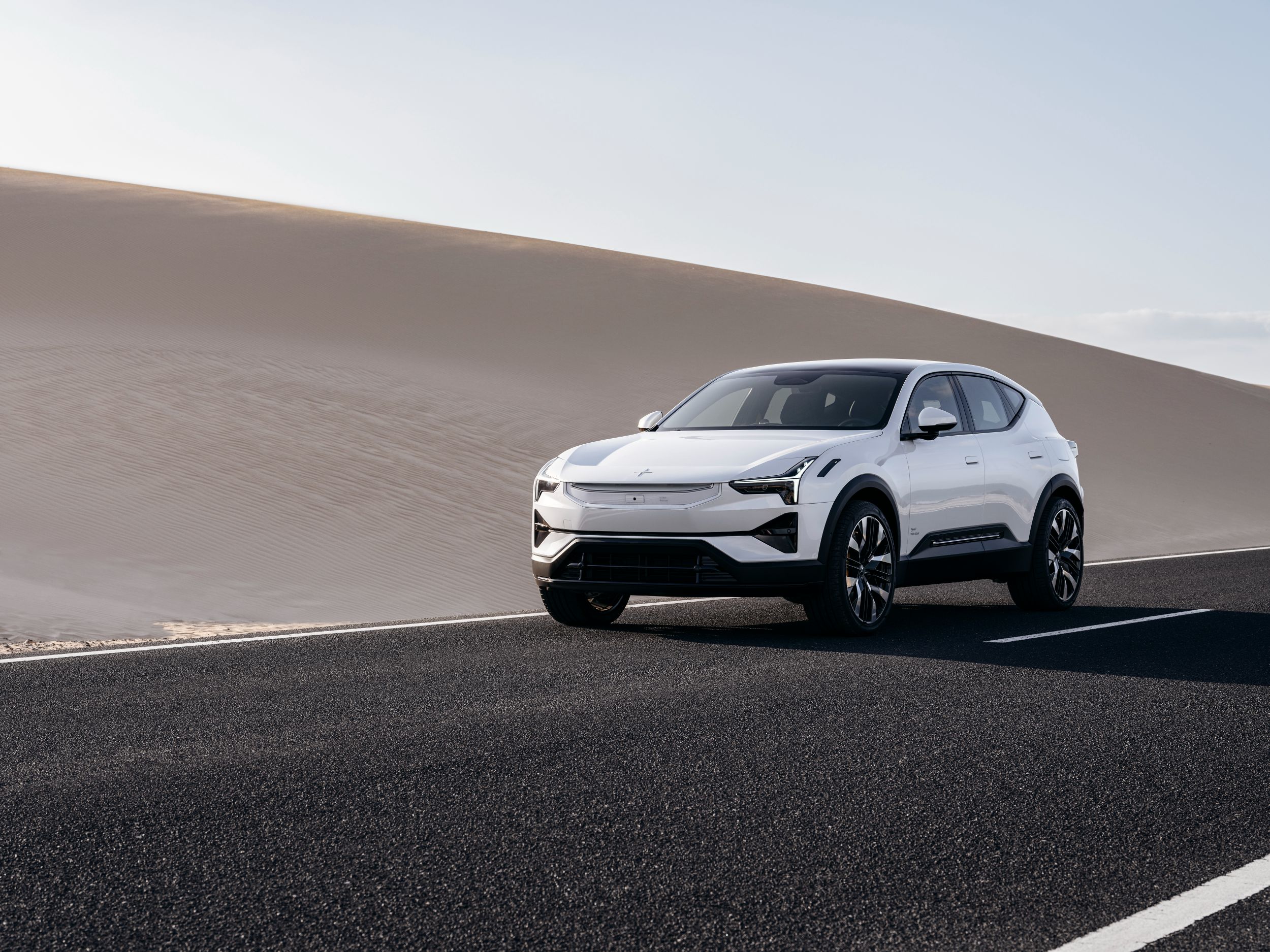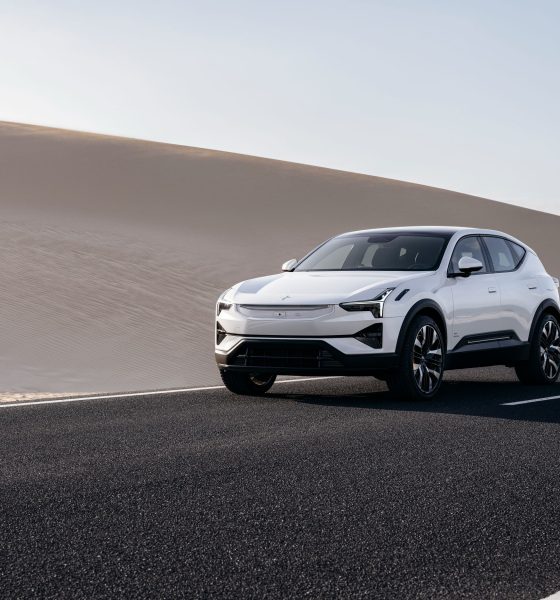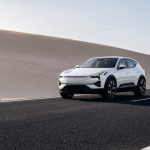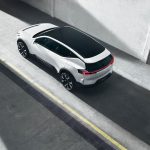

Investor's Corner
Polestar’s Q3 revenue and gross profit skyrocket, operating loss trims by 33%
Polestar’s (NASDAQ: PSNY) position as one of two global, pure electric vehicle makers was solidified with a strong Q3 earnings report that featured skyrocketing revenue and gross profit figures and an operating loss that was reduced by one-third. The Swedish automaker reiterated its 50,000-vehicle delivery goal, expecting Q4 to be its strongest three-month showing in company history.
Polestar’s revenue skyrocketed in Q3 from $748 million in 2021 to $1.477 billion this year. The growth was mainly driven by higher Polestar 2 sales and continued commercial expansion across markets. Revenue per vehicle decreased slightly, Polestar said, attributing the slight reduction to product and market mix.
Polestar is currently recognizing its active markets as Australia, Austria, Belgium, Canada, China, Denmark, Finland, Germany, Hong Kong, Iceland, Ireland, South Korea, Kuwait, Israel, Italy, Luxembourg, Netherlands, New Zealand, Norway, Portugal, Singapore, Spain, Sweden, Switzerland, the UAE, U.K., and the USA.
Gross profit also grew considerably compared to the same quarter in 2021. Polestar reported a $57 million gross profit in Q3 2022, up from just $1 million last year. This was a result of higher Polestar 2 sales and lower manufacturing costs, which come as companies scale the production of their vehicles. The gross profit growth was slightly offset by “the continued deterioration of the Swedish Krona versus Chinese Renminbi which led to higher cost of sales,” the automaker said.
Polestar accomplished five feats in Q3, including the launch of the Polestar 3, which was met with mixed reviews due to its stylish and competitive design that also features less-than-admirable efficiency. The event provided a spike to the company’s website, only succeeded by user visits following the Superbowl ad the company ran in February.
- (Credit: Polestar)
- Credit: Polestar
- Credit: Polestar
- Credit: Polestar
Polestar is reaching its 100,000-vehicle production milestone for the Polestar 2 in the near future. The company expects to meet this threshold in Q4 as it expects to deliver at least 19,500 vehicles in 2022’s final quarter. Polestar said it expects Q4 to be its biggest quarter to date as manufacturing growth continues to help the company solidify itself as a major player in the market.
The company’s $1.48 billion in revenues through the first nine months of 2022 only transitions into the $2.4 billion that Polestar expects to deliver for the full year. This is an estimated increase of 80 percent compared to 2021. It also obtained an additional $1.6 billion in financing and liquidity packages from major shareholders, which will, in addition to other potential financing activities, provide Polestar will sufficient funds to operate through 2023.
Polestar reduced SG&A expenses by 10 percent compared to Q3 2021, from a loss of $199 million to $179 million, and R&D expenses by 51 percent, from a loss of $51 million to a loss of $25 million. It also trimmed its operating loss by one-third compared to Q3 2021. These numbers tell a different story from the first nine months of 2021 compared to the same period this year.
SG&A was up 31 percent for the first nine months of 2022 compared to the same period in 2021. This was due to “rapid commercial expansion and significantly increased global presence.” R&D expenses were down 22 percent due to lower amortization. Meanwhile, operating loss was up 64 percent, “reflecting investment in the business growth and a $372 million non-recurring, non-cash listing expense.”
Polestar has launched production of the Polestar 3 and plans to start deliveries sometime early next year. It will also launch the Polestar 4 in early 2023, it said.
Polestar shares were up nearly 20 percent at the time of publishing, trading at $5.44 per share.
Disclosure: Joey Klender is not a Polestar investor or shareholder.
I’d love to hear from you! If you have any comments, concerns, or questions, please email me at joey@teslarati.com. You can also reach me on Twitter @KlenderJoey, or if you have news tips, you can email us at tips@teslarati.com.

Investor's Corner
Tesla stock closes at all-time high on heels of Robotaxi progress

Tesla stock (NASDAQ: TSLA) closed at an all-time high on Tuesday, jumping over 3 percent during the day and finishing at $489.88.
The price beats the previous record close, which was $479.86.
Shares have had a crazy year, dipping more than 40 percent from the start of the year. The stock then started to recover once again around late April, when its price started to climb back up from the low $200 level.
This week, Tesla started to climb toward its highest levels ever, as it was revealed on Sunday that the company was testing driverless Robotaxis in Austin. The spike in value pushed the company’s valuation to $1.63 trillion.
Tesla Robotaxi goes driverless as Musk confirms Safety Monitor removal testing
It is the seventh-most valuable company on the market currently, trailing Nvidia, Apple, Alphabet (Google), Microsoft, Amazon, and Meta.
Shares closed up $14.57 today, up over 3 percent.
The stock has gone through a lot this year, as previously mentioned. Shares tumbled in Q1 due to CEO Elon Musk’s involvement with the Department of Government Efficiency (DOGE), which pulled his attention away from his companies and left a major overhang on their valuations.
However, things started to rebound halfway through the year, and as the government started to phase out the $7,500 tax credit, demand spiked as consumers tried to take advantage of it.
Q3 deliveries were the highest in company history, and Tesla responded to the loss of the tax credit with the launch of the Model 3 and Model Y Standard.
Additionally, analysts have announced high expectations this week for the company on Wall Street as Robotaxi continues to be the focus. With autonomy within Tesla’s sights, things are moving in the direction of Robotaxi being a major catalyst for growth on the Street in the coming year.
Elon Musk
Tesla needs to come through on this one Robotaxi metric, analyst says
“We think the key focus from here will be how fast Tesla can scale driverless operations (including if Tesla’s approach to software/hardware allows it to scale significantly faster than competitors, as the company has argued), and on profitability.”

Tesla needs to come through on this one Robotaxi metric, Mark Delaney of Goldman Sachs says.
Tesla is in the process of rolling out its Robotaxi platform to areas outside of Austin and the California Bay Area. It has plans to launch in five additional cities, including Houston, Dallas, Miami, Las Vegas, and Phoenix.
However, the company’s expansion is not what the focus needs to be, according to Delaney. It’s the speed of deployment.
The analyst said:
“We think the key focus from here will be how fast Tesla can scale driverless operations (including if Tesla’s approach to software/hardware allows it to scale significantly faster than competitors, as the company has argued), and on profitability.”
Profitability will come as the Robotaxi fleet expands. Making that money will be dependent on when Tesla can initiate rides in more areas, giving more customers access to the program.
There are some additional things that the company needs to make happen ahead of the major Robotaxi expansion, one of those things is launching driverless rides in Austin, the first city in which it launched the program.
This week, Tesla started testing driverless Robotaxi rides in Austin, as two different Model Y units were spotted with no occupants, a huge step in the company’s plans for the ride-sharing platform.
Tesla Robotaxi goes driverless as Musk confirms Safety Monitor removal testing
CEO Elon Musk has been hoping to remove Safety Monitors from Robotaxis in Austin for several months, first mentioning the plan to have them out by the end of 2025 in September. He confirmed on Sunday that Tesla had officially removed vehicle occupants and started testing truly unsupervised rides.
Although Safety Monitors in Austin have been sitting in the passenger’s seat, they have still had the ability to override things in case of an emergency. After all, the ultimate goal was safety and avoiding any accidents or injuries.
Goldman Sachs reiterated its ‘Neutral’ rating and its $400 price target. Delaney said, “Tesla is making progress with its autonomous technology,” and recent developments make it evident that this is true.
Investor's Corner
Tesla gets bold Robotaxi prediction from Wall Street firm
Last week, Andrew Percoco took over Tesla analysis for Morgan Stanley from Adam Jonas, who covered the stock for years. Percoco seems to be less optimistic and bullish on Tesla shares, while still being fair and balanced in his analysis.

Tesla (NASDAQ: TSLA) received a bold Robotaxi prediction from Morgan Stanley, which anticipates a dramatic increase in the size of the company’s autonomous ride-hailing suite in the coming years.
Last week, Andrew Percoco took over Tesla analysis for Morgan Stanley from Adam Jonas, who covered the stock for years. Percoco seems to be less optimistic and bullish on Tesla shares, while still being fair and balanced in his analysis.
Percoco dug into the Robotaxi fleet and its expansion in the coming years in his latest note, released on Tuesday. The firm expects Tesla to increase the Robotaxi fleet size to 1,000 vehicles in 2026. However, that’s small-scale compared to what they expect from Tesla in a decade.
Tesla expands Robotaxi app access once again, this time on a global scale
By 2035, Morgan Stanley believes there will be one million Robotaxis on the road across multiple cities, a major jump and a considerable fleet size. We assume this means the fleet of vehicles Tesla will operate internally, and not including passenger-owned vehicles that could be added through software updates.
He also listed three specific catalysts that investors should pay attention to, as these will represent the company being on track to achieve its Robotaxi dreams:
- Opening Robotaxi to the public without a Safety Monitor. Timing is unclear, but it appears that Tesla is getting closer by the day.
- Improvement in safety metrics without the Safety Monitor. Tesla’s ability to improve its safety metrics as it scales miles driven without the Safety Monitor is imperative as it looks to scale in new states and cities in 2026.
- Cybercab start of production, targeted for April 2026. Tesla’s Cybercab is a purpose-built vehicle (no steering wheel or pedals, only two seats) that is expected to be produced through its state-of-the-art unboxed manufacturing process, offering further cost reductions and thus accelerating adoption over time.
Robotaxi stands to be one of Tesla’s most significant revenue contributors, especially as the company plans to continue expanding its ride-hailing service across the world in the coming years.
Its current deployment strategy is controlled and conservative to avoid any drastic and potentially program-ruining incidents.
So far, the program, which is active in Austin and the California Bay Area, has been widely successful.












